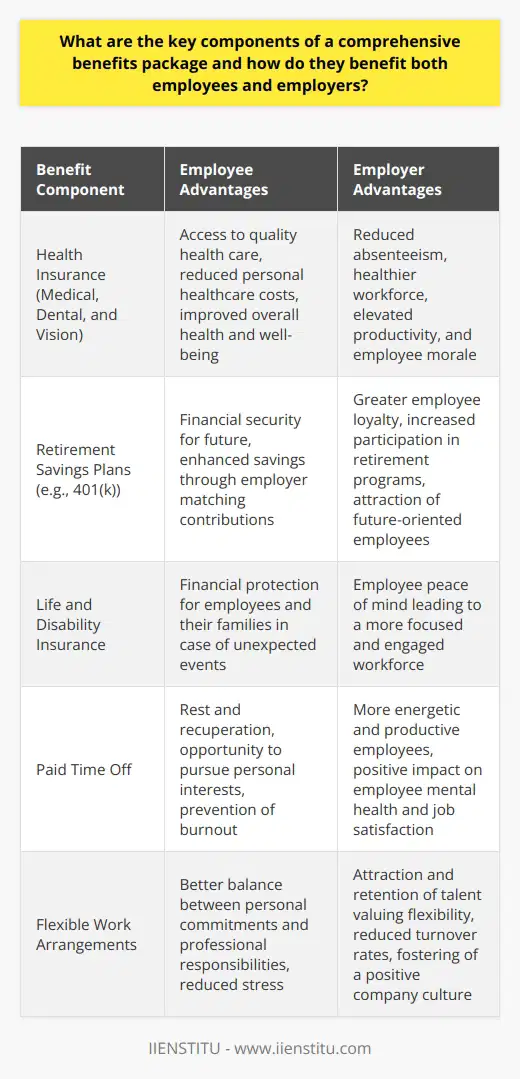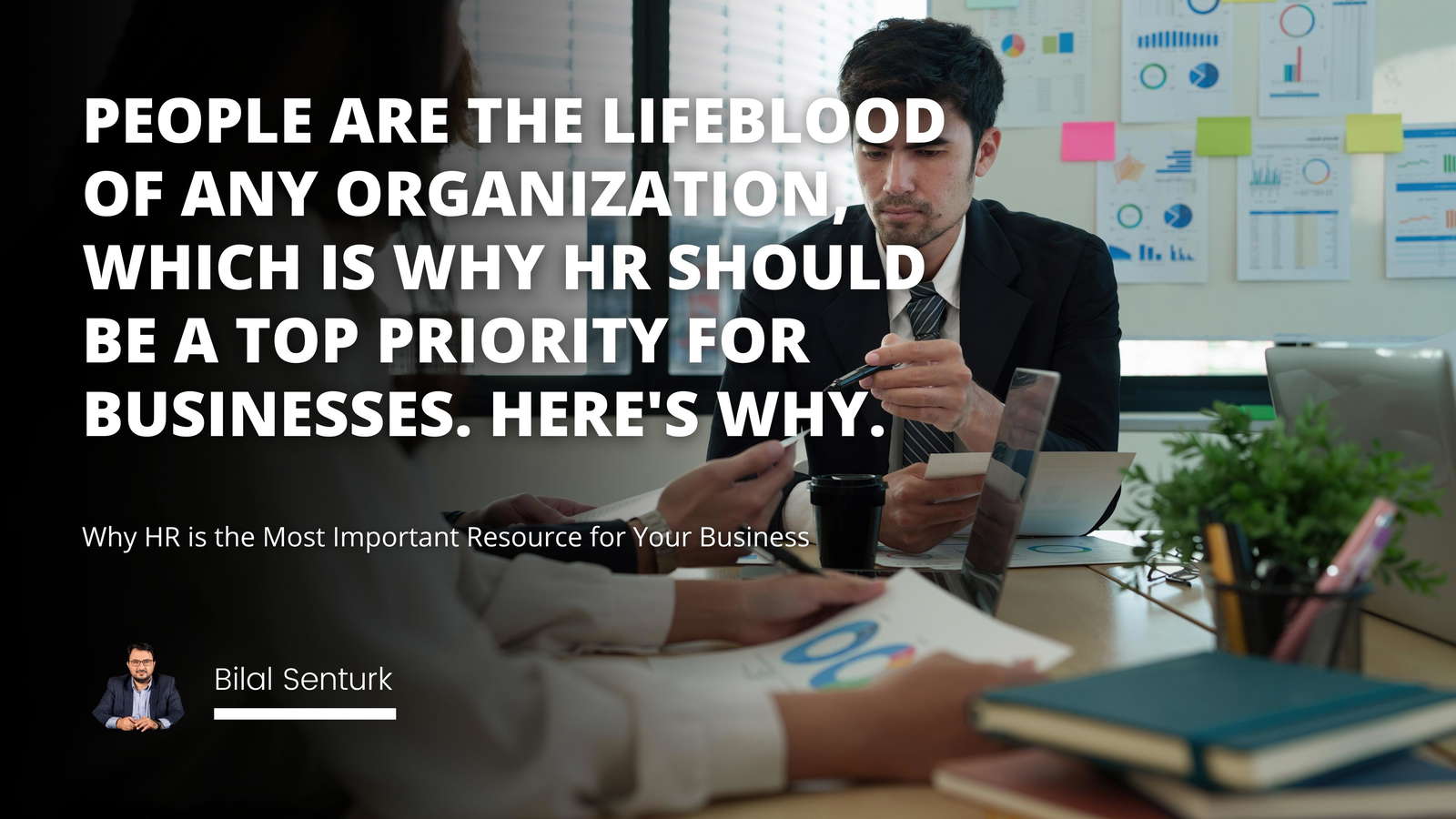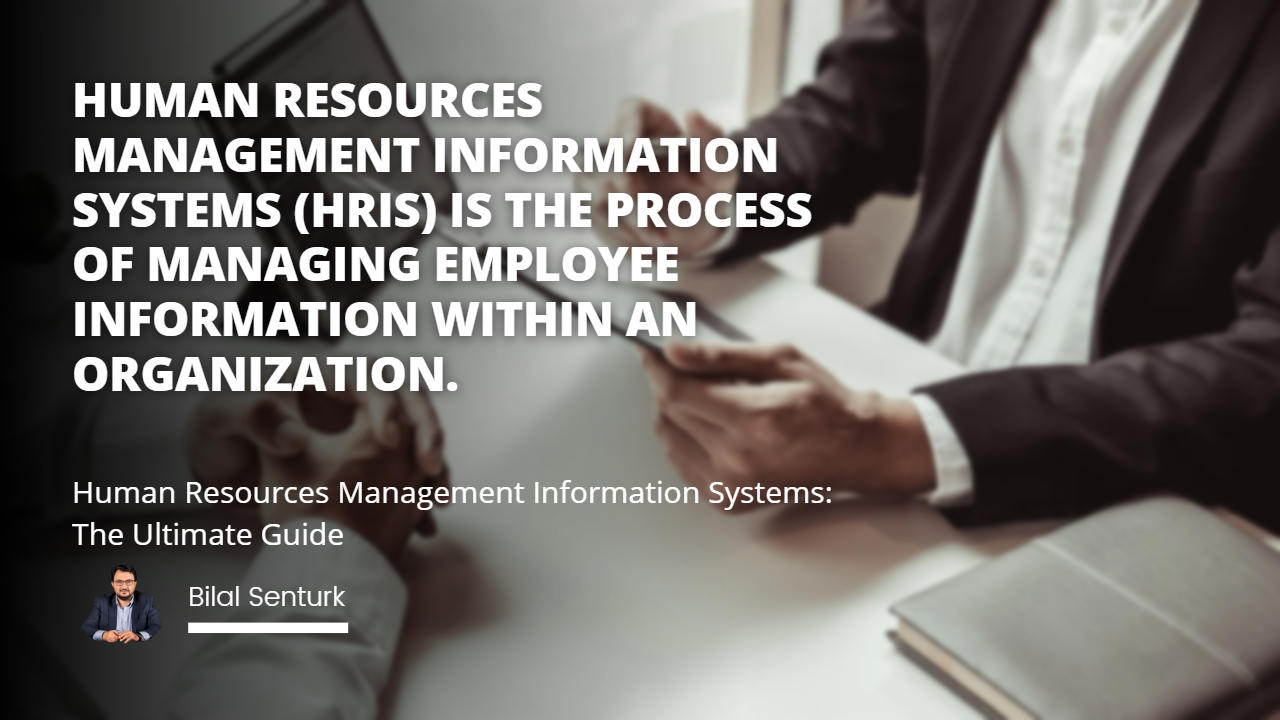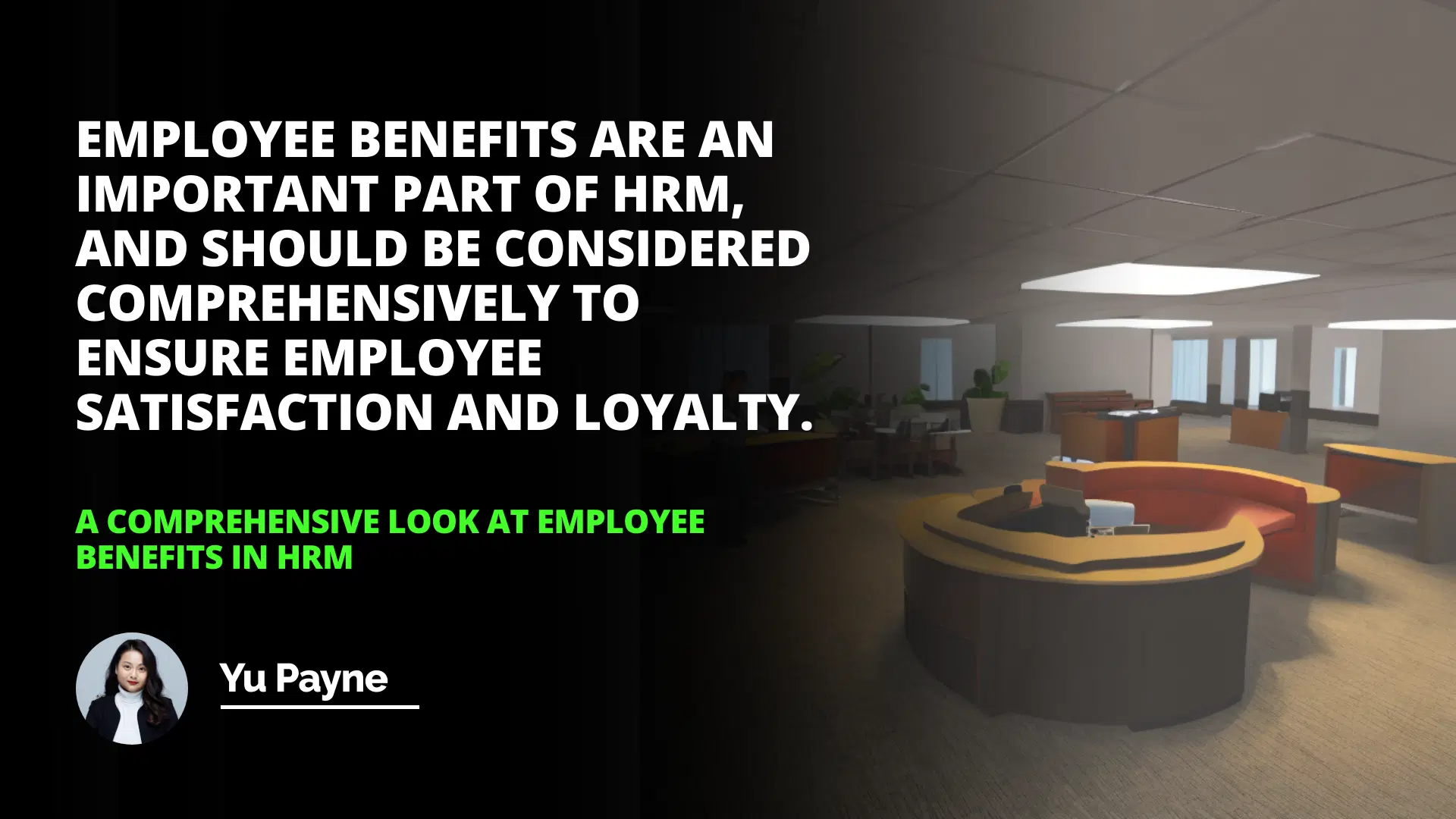
This article has provided an overview of the different types of employee benefits, such as legally required payments, payments for time not worked, employer's share of medical and medically related payments, and miscellaneous benefit payments. These benefits can provide a variety of advantages to employees, such as financial assistance, time away from work, and medical care.
Introduction
Definition of Employee Benefits
Legally Required Payments
Social Security and Medicare
Unemployment Insurance
Employee Benefits: A Broad View
Employee benefits are essential to a job and can be a deciding factor when considering potential employers. Understanding the different types of available benefits and what they mean for employees is essential. This article will provide an overview of the different types of employee benefits and how they can benefit employees.
Definition of Employee Benefits
Employee benefits are any form of compensation other than direct wages, such as legally required payments, payments for time not worked, and various benefits. These benefits can be used to supplement an employee’s wages and provide various advantages to employees.
Legally Required Payments
Employers are required to make certain payments to employees as part of their employment. These payments include Social Security and Medicare, unemployment insurance, and workers’ compensation benefits. These payments are intended to provide a safety net for employees and are required by law.
Payments for Time Not Worked
Overtime Pay: Comprehensive Analysis of Policies and Regulations
HR Crisis Management: Navigating Challenges & Mitigating Risks
Employee Turnover: An In-depth Analysis and Strategic Approach
Employers may also provide payments for time not worked, such as paid rest periods, paid sick leave, paid vacations, holidays, and parental leave. These payments are intended to provide employees with time away from work and can benefit both employees and employers.
Employer’s Share of Medical and Medically Related Payments
Employers may also provide payments for medical and medically related expenses, such as health insurance premiums, dental care, vision care, and prescription drug coverage. These payments can be used to help employees cover the costs of medical care and can help to reduce the financial burden of medical bills.
Miscellaneous Benefit Payments
Employers may also provide miscellaneous benefit payments, such as employee discounts, severance pay, educational expenditures, and child care. These payments can provide additional financial assistance to employees and can be used to supplement an employee’s wages.
Conclusion: Employee benefits are an essential part of a job and can provide a variety of advantages to employees. Understanding the different types of available benefits and how they can benefit employees is essential. This article has provided an overview of the different types of employee benefits and how they can benefit employees.
Employee benefits are essential to HRM and should be considered comprehensively to ensure employee satisfaction and loyalty.

Frequently Asked Questions
What are the legally required payments for employee benefits?
Employee benefits are essential for a successful business, as they can help ensure employee satisfaction and motivation. Employers need to understand the legal requirements for providing employee benefits, as failure to comply with these regulations can lead to legal action. This article will provide an overview of the legally required payments for employee benefits.
Firstly, all employers must provide certain employee benefits, such as basic wages, holiday pay, and statutory sick pay. The relevant statutory regulations must provide these benefits. Additionally, employers may be required to make additional payments for certain benefits, such as pensions and health insurance.
In addition to the legally required payments, employers may also be obligated to provide additional benefits, such as bonuses and other incentives. These benefits may be provided at the employer’s discretion. Still, employers should be aware that they may be subject to labor laws, such as the Fair Labor Standards Act (FLSA), which governs the payment of bonuses and other incentives.
Employers should also be aware of any tax implications when providing employee benefits. In some cases, employers must withhold taxes from employee benefits, such as pension payments, and ensure that they comply with relevant tax regulations.
Finally, employers should also be aware of their obligations concerning employee privacy. In many cases, employers must maintain employee information confidentiality, such as salary details and other personal information. Employers should ensure they comply with relevant laws and regulations regarding employee privacy.
In summary, employers should know their legal obligations regarding employee benefits. Employers should ensure that they comply with relevant laws and regulations and are aware of any tax implications associated with providing employee benefits.
Additionally, employers should be aware of their obligations concerning employee privacy. By understanding their legal requirements, employers can ensure that they provide employees with the benefits they are entitled to and remain compliant with relevant laws and regulations.

What types of payments are provided for time not worked?
Time not worked is a term used to refer to hours that an employee is not physically present in the workplace. It includes unpaid leave, jury duty, and personal days. As such, employers need to understand employee payments for time not worked.
When it comes to paid time off, employers typically offer employees a certain number of paid days each year. This can be in the form of either vacation time or sick days. Vacation time is typically given to employees to allow them to take time off for leisure purposes.
At the same time, sick days are usually intended to allow employees to take time off to address medical issues. In addition, some employers may also provide employees with additional paid days off to use at their discretion, such as personal days.
For employees who are required to take unpaid leave, such as jury duty or military leave, employers may choose to provide employees with some form of payment. In some cases, employers may offer employees a certain amount of salary instead of their regular pay. Alternatively, employers may provide employees with a lump sum payment for the time not worked.
Finally, some employers may offer employees a combination of both paid and unpaid time off. For example, employers may offer employees a certain number of paid days off for vacation and sick days and a certain amount of unpaid leave for jury duty or military leave. In such cases, employers should ensure that they provide employees with a fair and equitable payment for their time not worked.
Overall, employers have various options when paying employees for time not worked. Employers should consider the various types of payments available and choose the one that best meets the needs of their workers. In doing so, employers can ensure that their employees are adequately compensated for their time not working while ensuring that their business complies with applicable laws.

What are some of the miscellaneous benefit payments employers may provide?
Employer-provided benefit payments have become increasingly commonplace as employers seek to retain and attract workers in a competitive labor market. While traditional benefits such as health insurance and retirement savings plans are often the first to come to mind, employers may provide various miscellaneous benefit payments.
One common type of miscellaneous benefit payment is assistance with educational costs. For example, many employers offer tuition reimbursement or educational assistance programs to help employees pursue postsecondary education or training. These programs may include rebates for tuition, fees, books, and other related expenses.
Employers may also provide additional payment for employees who use public transportation to travel to and from work. Commuter benefits may include pre-tax deductions for transit passes, vanpools, and parking and employer-funded payments to offset commuting costs.
Some employers offer wellness programs to help employees maintain their health and well-being. These programs may include reimbursement for gym memberships, health club expenses, smoking cessation classes, and other health-related programs.
In addition, employers may offer flexible spending accounts (FSAs) to help employees manage their healthcare costs. FSAs allow employees to set aside pre-tax money to pay for health-related expenses such as deductibles, copayments, and prescriptions.
Finally, employers may provide employees with additional payment for performing specific duties. Examples of such tasks include on-call responsibilities, hazardous duties, or other duties requiring a higher level of skill or effort.
In conclusion, there are a variety of miscellaneous benefit payments that employers may provide. These payments can help employers retain and attract workers and promote employee health and well-being.
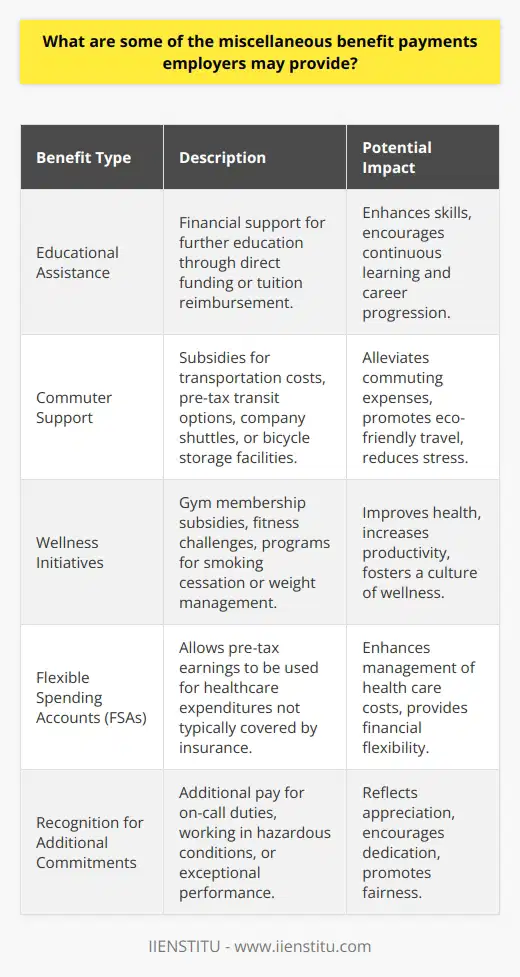
What is meant by employee benefits in HR?
Defining Employee Benefits in HR
Employee benefits, also known as fringe benefits or perks, are supplementary forms of compensation provided to employees by their employers. These benefits are designed to promote employee well-being, satisfaction, and retention, as they enhance the overall compensation package offered by the employer. They may include health insurance, pension plans, educational assistance, and wellness programs, among others.
Types of Employee Benefits
Mandatory Benefits: Some employee benefits are legally mandated by government regulations. These may include social security contributions, workers' compensation, maternity and paternity leave, and disability insurance. Employers are obligated to provide such benefits to their employees to ensure a minimum level of social protection and to safeguard employees' rights.
Voluntary Benefits: Beyond government-mandated benefits, employers may choose to offer additional voluntary employee benefits as a competitive advantage. These voluntary benefits can range from health and dental insurance to gym memberships, flexible work arrangements, and even pet insurance. Offering a wide range of voluntary benefits allows employers to cater to the diverse needs and preferences of their workforce, resulting in greater employee satisfaction and engagement.
Non-financial Benefits: Besides the traditional financial benefits, employers may also offer non-financial benefits to enhance employees' work environment and job satisfaction. Examples include skill development and training programs, mentorship opportunities, employee assistance programs, and team-building initiatives. These non-financial benefits contribute to an organization's positive culture and are valuable tools for attracting and retaining top talent.
The Role of HR in Employee Benefits
Designing and Managing Benefits: Human Resources (HR) plays a critical role in designing and managing employee benefits. HR professionals must assess the organization's objectives, budget, and employee demographics to determine the optimal mix of employee benefits that will attract and retain top talent while aligning with the organization's budgetary constraints.
Communication and Education: HR is also responsible for effectively communicating the available benefits to employees and educating them about the full value of their compensation package. Ensuring employees are well-informed about their benefits can lead to increased employee engagement and satisfaction, which ultimately contributes to the organization's overall success.
Compliance and Administration: Finally, HR must ensure that the organization complies with relevant labor laws and regulations, as well as effectively administer employee benefit programs. This includes timely processing of claims, updating benefits offerings in response to legislative changes, and maintaining accurate records.
In conclusion, employee benefits are a vital component of the HR domain that encompasses mandatory, voluntary, and non-financial benefits provided by an employer to enhance employee well-being and satisfaction. As the architects and stewards of these benefits, HR professionals play an essential role in designing, communicating, and managing an organization's employee benefits strategy to support a motivated and productive workforce.
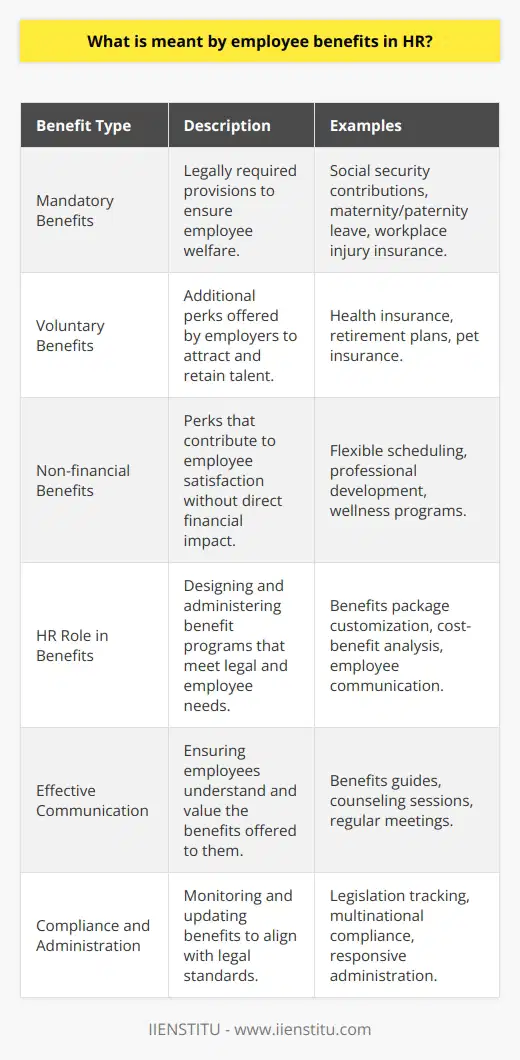
How does HR manage employee benefits?
Role of HR in Employee Benefits Management
The management of employee benefits constitutes a crucial aspect of Human Resource (HR) departments' responsibilities. Typically, HR professionals ensure that organizations provide competitive and well-structured benefits packages that both attract and retain employees. In this regard, HR plays a vital role in designing, implementing, and managing employee benefits programs in line with organizational goals and employee needs.
Benefits Package Design
An integral responsibility of HR is to create benefits packages that appeal to the diverse needs of the workforce. These packages often include elements such as health insurance, retirement savings plans, and paid time off. Additionally, HR professionals must remain informed about industry trends and legal requirements to ensure that the organization offers a comprehensive and competitive benefits package that meets employees' evolving expectations.
Communication and Education
Effective communication of benefits packages to employees is another critical function of the HR department. HR must ensure that employees clearly understand the offered benefits and know how to access them. This process generally involves providing educational materials, organizing benefits fairs, conducting webinars or seminars, and establishing accessible information channels. Such initiatives create awareness and promote employees' active participation in the benefits programs, leading to higher employee satisfaction and engagement.
Benefits Administration
The HR department also oversees the day-to-day administration of employee benefits programs, ensuring that employees receive the benefits they are entitled to. This entails keeping accurate records, processing benefit claims, resolving disputes or issues, and liaising with benefits providers. Moreover, HR professionals often use technology platforms to streamline and automate benefits administration processes, enabling them to manage the programs efficiently and cost-effectively.
Monitoring and Evaluation
HR managers continuously evaluate the effectiveness of employee benefits programs by gathering employee feedback, analyzing benefits utilization data, and assessing the overall impact on employee engagement and satisfaction. They compare the organization's benefits offerings against industry benchmarks and competitors, identifying areas for improvement or innovation. Based on this analysis, HR practitioners may recommend adjustments to benefit programs to help the organization maintain competitiveness in the labor market and promote a healthy work-life balance for employees.
In conclusion, HR departments play a vital role in managing employee benefits to promote employee satisfaction and retention. They design competitive benefits packages, communicate and educate employees about their benefits, oversee the administration of benefits programs, and continuously evaluate and improve those programs. As employees increasingly value organizations that support their well-being, the importance of HR's role in managing benefits will continue to grow.
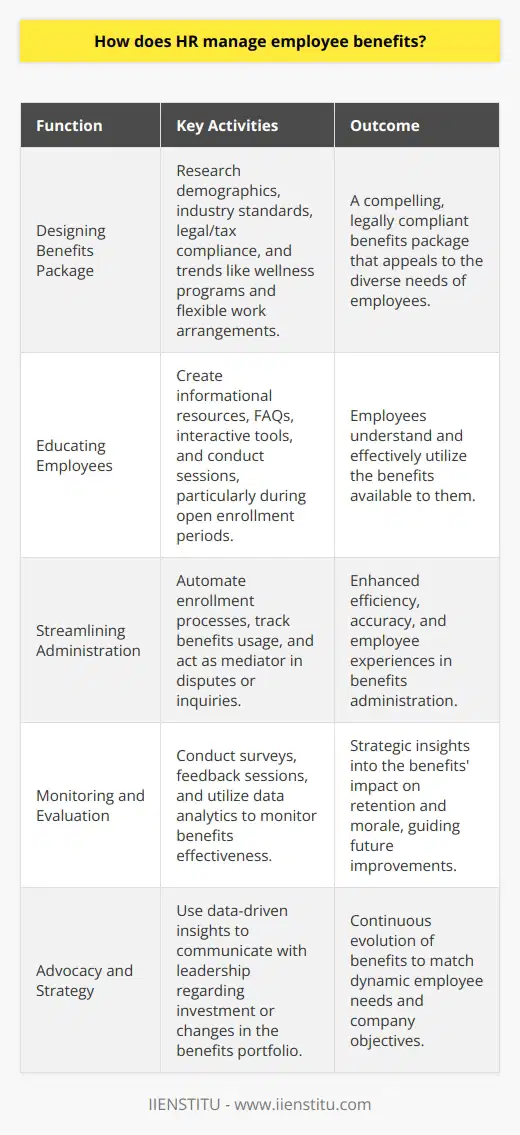
What is an example of a comprehensive benefits package?
Comprehensive Benefits Packages in the Workplace
A comprehensive benefits package refers to a collection of compensatory rewards offered by employers to employees, in addition to their regular salaries or wages. These packages typically include a combination of various benefits, aimed at fulfilling the diverse needs of employees and contributing to their overall job satisfaction.
Health and Wellness Benefits
One striking example of such a package is the one provided by Google, a multinational technology company known for its innovative and employee-centric approach. Google's comprehensive benefits package includes extensive health and well-being support, such as comprehensive medical, dental, and vision coverage for employees and their dependent family members. In addition, the company offers access to on-site healthcare services, mental health resources, and wellness programs.
Financial Security and Savings
Google's benefits package also addresses employees' financial needs by offering competitive retirement options, such as a 401(k) savings plan with a company match. Additionally, Google employees can benefit from financial planning resources, discounted stock purchase plans, and generous parental leave policies that include both maternity and paternity leave options.
Work-Life Balance and Flexibility
Work-life balance is another critical aspect addressed in Google's comprehensive benefits package, providing employees with several options to maintain a healthy and balanced lifestyle. The company encourages a flexible work schedule, allowing employees to telecommute or work from home when necessary. Furthermore, Google supports its employees with generous paid time off, such as vacations, sick days, and personal time.
Employee Development and Growth
The comprehensive benefits package provided by Google also encompasses opportunities for employees' professional growth and development. This includes extensive training and development programs, access to industry conferences and events, and continuous learning opportunities such as workshops and online courses. Google places a high value on its employees' skills and invests in their growth to bolster productivity and innovation within the organization.
Perks and Additional Benefits
Google's comprehensive benefits package stands out due to its unique and attractive perks that further contribute to employees' satisfaction and motivation. Such perks include providing free gourmet meals and snacks on-site, outdoor sports facilities, and subsidized massage services. Additionally, Google offers discounts on various goods and services, as well as support resources for life events such as adoption or bereavement.
In conclusion, a comprehensive benefits package, such as the one offered by Google, combines various elements that cater to the diverse needs of employees within the workplace, fostering a productive and motivated workforce.
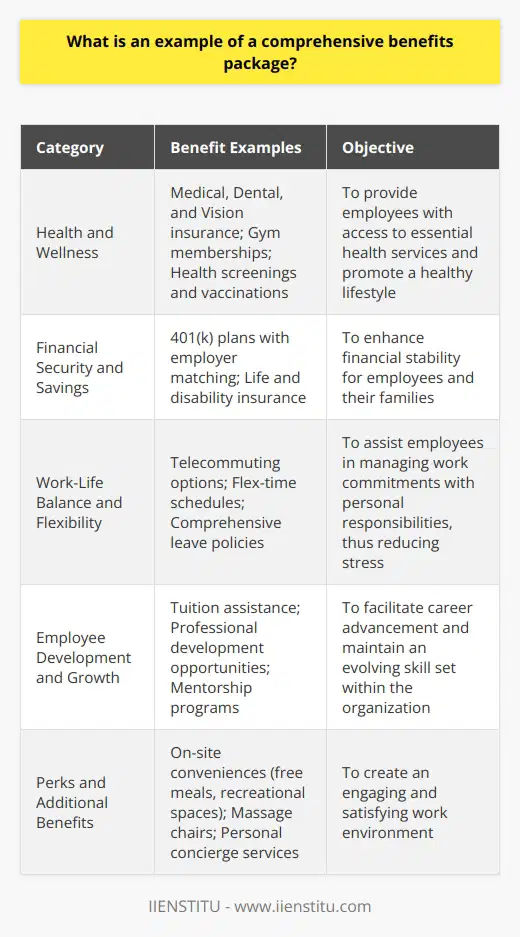
What is a comprehensive benefit?
Defining Comprehensive Benefit
In the context of a blog post, a comprehensive benefit refers to the cumulative positive outcomes or advantages derived from the implementation of a specific policy, program, or initiative. This concept is crucial when examining the effectiveness and impact of a particular action or decision, as it takes into account all potential gains, rather than focusing on one specific aspect or considering just the immediate advantages.
Multiple Dimensions of Benefits
A comprehensive benefit can be viewed through various dimensions, including but not limited to economic, social, environmental, and organizational aspects. For instance, economic benefits encompass increased profits, savings, or cost reductions, while social benefits involve improved well-being, education, or public health conditions. Environmental benefits could refer to the reduction of emissions, conservation of resources, or preservation of biodiversity, and organizational benefits may include enhanced reputation, increased employee satisfaction, or efficient management of resources.
Interconnections and Trade-offs
It is also important to recognize that the different dimensions of a comprehensive benefit are often interconnected, and there may be trade-offs between them. For example, a policy that promotes economic growth might negatively impact the environment, leading to a decrease in the overall benefit that it provides. Hence, when evaluating a comprehensive benefit, it is essential to consider these interconnections and identify trade-offs, ensuring that the wide-ranging outcomes are accounted for and balanced appropriately.
Metrics for Evaluation
To assess comprehensive benefits, relevant metrics and indicators should be employed, tailored to the specific context and objectives of the initiative or policy. These metrics could vary from quantifiable data such as cost savings, revenue increases, or emission reductions, to qualitative measures like employee satisfaction or quality of life improvements. Additionally, it is imperative to conduct thorough and consistent evaluations, allowing for adjustments and improvements to maximize the comprehensive benefit continuously.
In conclusion, the concept of a comprehensive benefit enables the holistic interpretation of the positive outcomes resulting from a specific decision, policy, or program. By considering multiple dimensions, trade-offs, and using appropriate metrics, it is possible to assess the overall impact and effectiveness of a given initiative, ultimately supporting the design and implementation of actions that yield the most extensive positive consequences for all stakeholders involved.
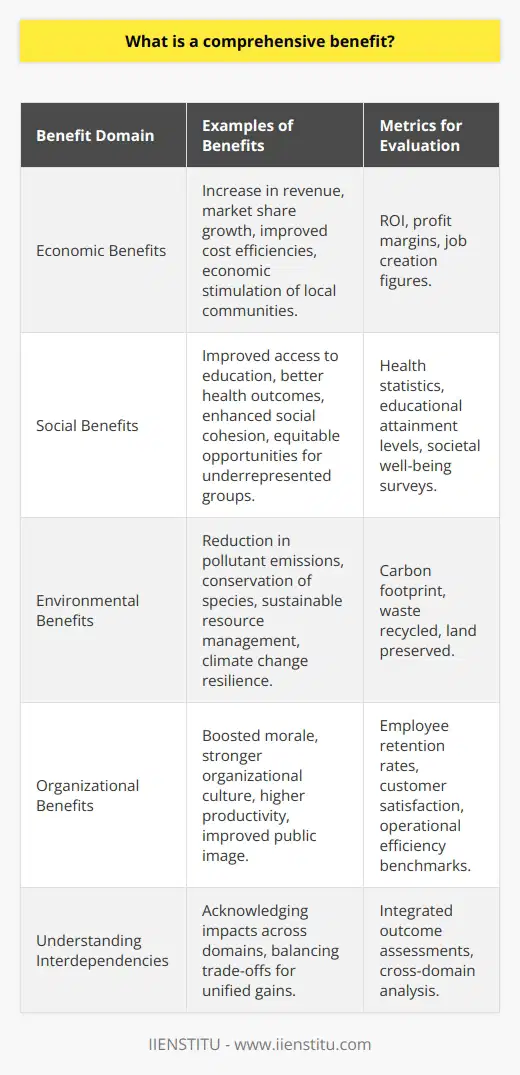
What are the 4 major types of employee benefits?
Major Types of Employee Benefits
Health Benefits
One major type of employee benefits is health benefits, which typically include medical, dental, and vision insurance coverage. These benefits are essential for employees, as they help cover the costs of healthcare services and provide financial protection against unexpected medical expenses.
Retirement Benefits
Another key type of employee benefits is retirement benefits, which are designed to provide financial support to employees once they retire from the workforce. Common retirement benefits include pension plans and 401(k) plans, both of which help employees save for their future and encourage long-term financial planning.
Paid Time Off
Paid time off (PTO) is another crucial employee benefit, as it allows employees to take time away from work without losing their income. PTO encompasses various forms of leave, such as vacation days, sick days, and personal days. By offering PTO, employers can help promote a healthy work-life balance and boost employee morale and productivity.
Professional Development Benefits
Lastly, professional development benefits are a vital component of employee benefits packages. These benefits can include tuition reimbursement, training programs, and access to industry conferences and workshops. By providing opportunities for professional growth, employers can help employees expand their skillset, increase their job satisfaction, and enhance their overall career development.
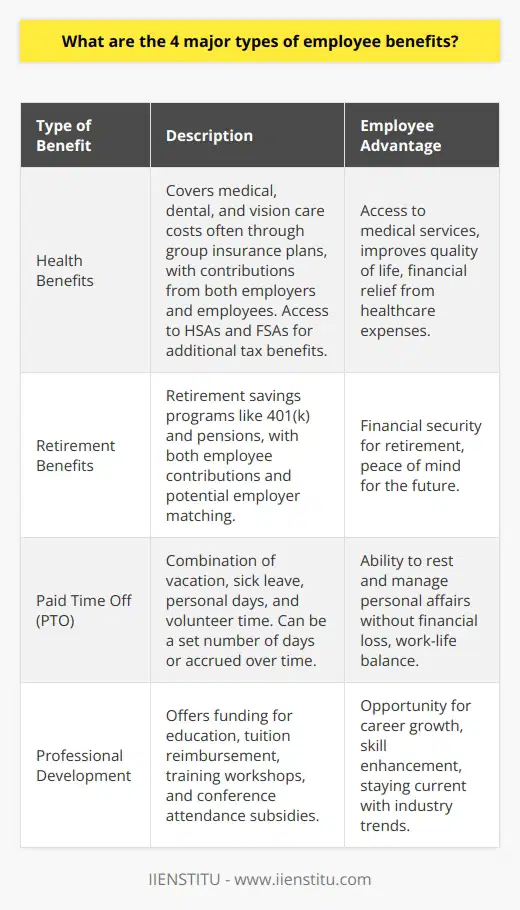
What is meant by employee benefits in HR?
Definition of Employee Benefits
Employee benefits refer to the wide array of non-monetary compensation provided to employees in addition to their regular wages or salaries. These benefits are designed to enrich the overall employment experience, promote employee satisfaction, and increase staff retention.
Types of Employee Benefits
Common employee benefits include healthcare coverage, retirement savings plans, paid leave, and various insurance policies. Employers may offer these benefits voluntarily or be required by law to provide certain benefits, such as workers' compensation or social security contributions.
Role of HR in Employee Benefits
Human Resources (HR) departments play a vital role in managing employee benefits, ensuring that packages offered align with company goals and comply with legal requirements. HR professionals design, negotiate, and administer benefit programs while effectively communicating their value to the workforce.
Importance of Employee Benefits
Employee benefits not only contribute to employees' financial security and wellbeing, but also serve as a critical component in recruiting and retaining top talent. A competitive benefits package can give a company an edge in attracting candidates and help cultivate a positive organizational culture.
In conclusion, employee benefits are non-monetary offerings that supplement an employee's salary and enhance their overall job satisfaction. HR departments are responsible for managing and administering these benefits, which play an important role in both employee wellbeing and workplace culture.

What is the meaning of comprehensive benefits in the context of employee compensation?
Comprehensive Benefits Definition
In the context of employee compensation, comprehensive benefits refer to the diverse and inclusive range of non-monetary rewards offered by an employer in addition to the base salary. These benefits aim to improve employees' overall well-being, job satisfaction, and work-life balance.
Types of Comprehensive Benefits
Health and Wellness Benefits
These benefits include medical, dental, and vision insurance, as well as access to wellness programs, gym memberships, and mental health support.
Retirement and Financial Security Benefits
Employers may offer a pension plan, 401(k) or other retirement savings options, along with financial planning assistance, in order to support employees' long-term financial well-being.
Work-Life Balance Benefits
Flexible work schedules, telecommuting options, and generous vacation and sick leave policies all contribute to employees' ability to maintain a healthy work-life balance.
Professional Development Benefits
Offering opportunities for employees to attend conferences, workshops, and training courses can support their professional growth and career advancement within the company.
Family and Parental Benefits
Employers might provide benefits such as paid parental leave, childcare assistance, or eldercare support in order to help employees meet their family responsibilities.
The Importance of Comprehensive Benefits
Offering comprehensive benefits can be a strategic advantage for employers, as it helps attract and retain top talent. Studies have consistently shown that employees who feel valued and supported through comprehensive benefits packages are more likely to be engaged, productive, and loyal to their company.
Moreover, investing in employees' well-being can lead to positive outcomes for the organization, such as reduced absenteeism, lower turnover rates, and a more positive work environment.
In conclusion, comprehensive benefits are an essential aspect of employee compensation, as they provide a holistic approach to supporting employees across various aspects of their lives. Offering a diverse range of benefits can be a powerful tool for employers seeking to increase job satisfaction, improve employee retention, and ultimately foster a thriving, committed workforce.
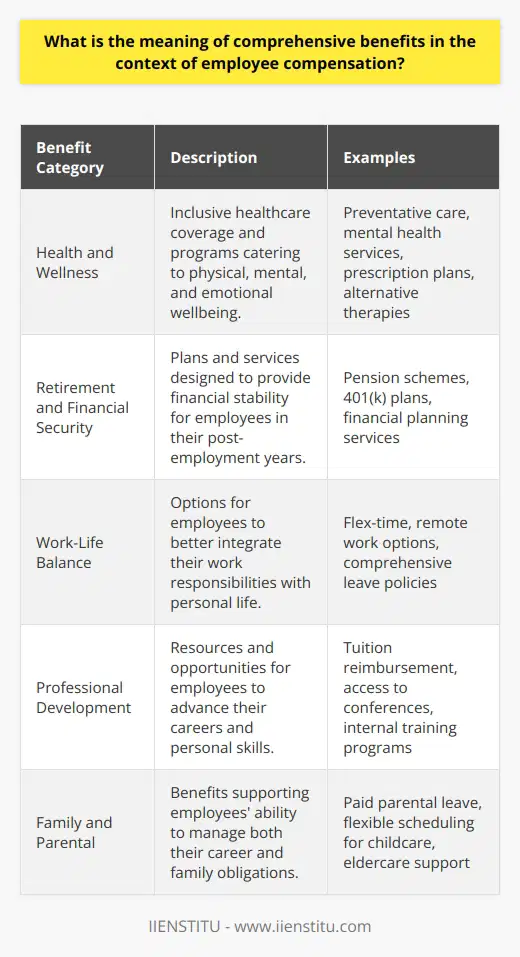
How do comprehensive employee benefits packages contribute to employee satisfaction and retention?
Impact on Employee Satisfaction
Comprehensive employee benefits packages play a crucial role in enhancing employee satisfaction. When companies provide their workforce with an array of benefits, employees view it as a sign of the organization's commitment to their well-being. These benefits can include health insurance, retirement plans, paid time off, and flexible work arrangements. By offering such attractive packages, companies demonstrate their appreciation for the hard work and dedication of their employees, contributing to a happy and satisfied workplace.
Boosting Employee Retention
Retention is another critical area that comprehensive benefits packages positively affect. Employees are more likely to remain with their current employer when they receive a competitive and well-rounded benefits package. The security and stability that these packages provide give employees a sense of loyalty towards the organization, reducing their motivation to search for other job opportunities. As a result, employers can drastically decrease the costs and disruptions associated with employee turnover.
Attracting Top Talent
In today's competitive job market, businesses must ensure they design benefits packages that appeal to the diverse preferences and needs of potential candidates. Comprehensive benefits packages not only retain existing employees but also attract top talent. When job seekers are evaluating potential employers, a standout benefits package could sway their decision in favor of an organization that demonstrates its commitment to employee welfare.
Increased Productivity
Investing in comprehensive employee benefits packages also leads to increased productivity in the workplace. When employees feel cared for and valued, they are more likely to be engaged and committed to their work, leading to higher productivity levels. A positive workplace environment, fostered by employee satisfaction, results in better communication, collaboration, and innovation.
In conclusion, comprehensive employee benefits packages significantly contribute to employee satisfaction and retention. By providing competitive benefits, employers attract top talent and maximize productivity, thus ensuring the overall success of the organization.
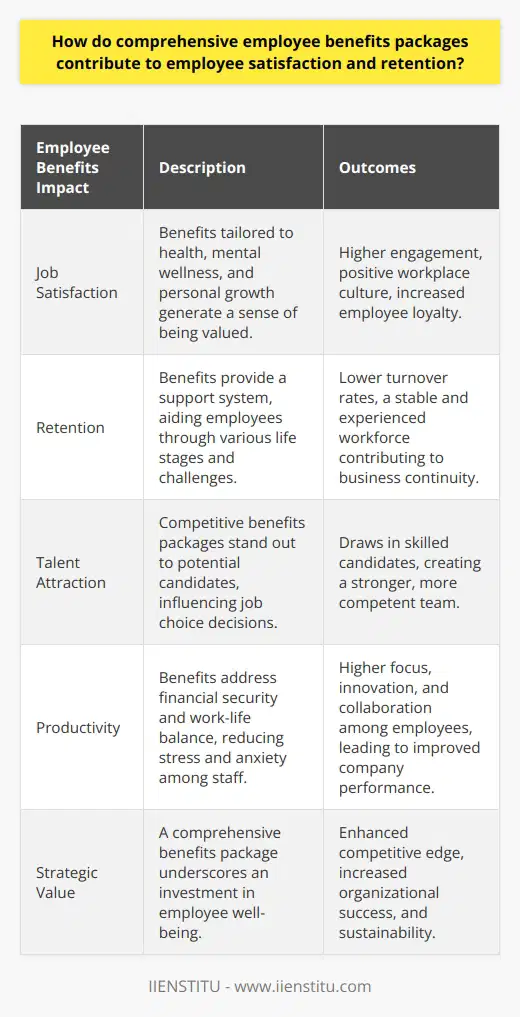
What are the key components of a comprehensive benefits package and how do they benefit both employees and employers?
Key Components of a Comprehensive Benefits Package
A comprehensive benefits package typically includes various elements that cater to the diverse needs of employees and provide value for employers. The core components encompass health and well-being, financial security, and work-life balance initiatives.
Health and Well-being
Healthcare benefits are crucial for employees, as they ensure access to necessary medical services. Employers usually offer medical, dental, and vision insurance, which cover a range of treatments and services. These benefits promote employee health, consequently increasing productivity, morale, and loyalty.
Financial Security
Retirement plans, such as 401(k) or pension schemes, give employees the opportunity to save for their future. Employers often contribute a percentage to these savings to encourage participation. These plans provide long-term financial security, attracting and retaining top talent.
Disability and life insurance policies act as additional protection for employees in case of unforeseen challenges. These policies provide financial support during difficult times, fostering a sense of security and alleviating stress.
Work-Life Balance Initiatives
Paid time off (PTO), inclusive of holidays, sick days, and vacation, is an essential aspect of work-life balance. It allows employees to rest and rejuvenate, leading to improved mental health and increased productivity. Employers benefit from a more engaged workforce that is less susceptible to burnout.
Flexible work arrangements, such as telecommuting or flexible schedules, cater to employees with different personal needs and preferences. This flexibility increases job satisfaction, resulting in better employee retention and attraction rates.
Conclusion
In summary, a comprehensive benefits package is essential for both employees and employers. Health and well-being initiatives, financial security measures, and work-life balance programs benefit employees by addressing their diverse needs. In turn, employers gain a motivated, healthy, and loyal workforce that contributes to their organization's success.
